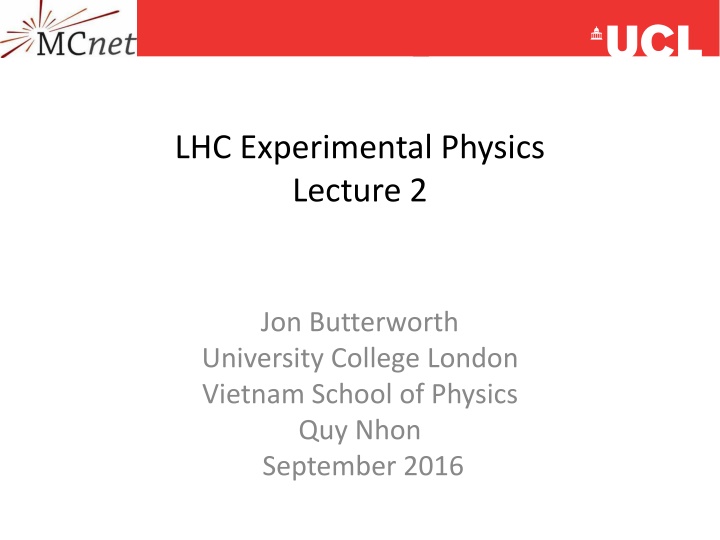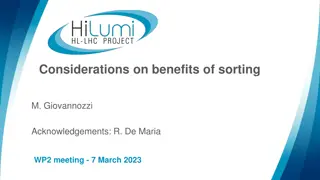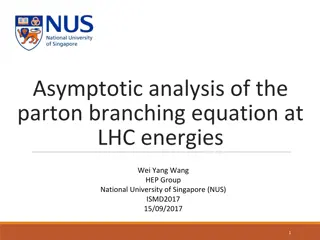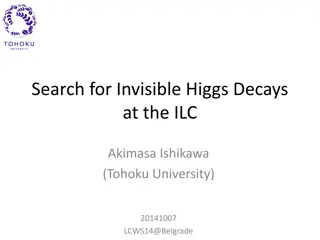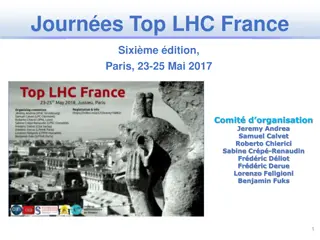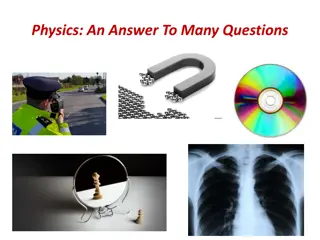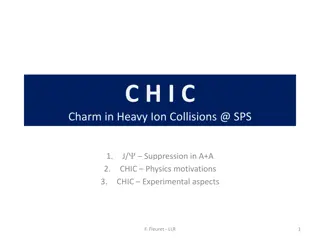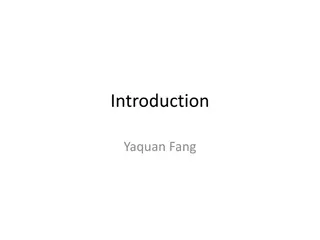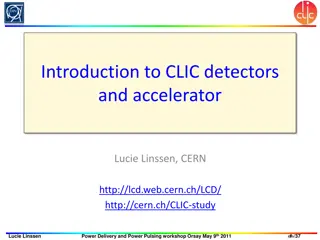Insights into LHC Experimental Physics: Lecture Highlights and Challenges
Delve into the world of experimental physics at LHC with lectures by Jon Butterworth at University College London in September 2016. Topics covered include accelerators, detectors, principles, and digressions, along with discussions on triggers, multi-level trigger systems, and collision selection methods. Explore the methodology behind rejecting collisions, distributing decision burdens, and selecting interesting collisions for further analysis in particle physics.
Download Presentation

Please find below an Image/Link to download the presentation.
The content on the website is provided AS IS for your information and personal use only. It may not be sold, licensed, or shared on other websites without obtaining consent from the author.If you encounter any issues during the download, it is possible that the publisher has removed the file from their server.
You are allowed to download the files provided on this website for personal or commercial use, subject to the condition that they are used lawfully. All files are the property of their respective owners.
The content on the website is provided AS IS for your information and personal use only. It may not be sold, licensed, or shared on other websites without obtaining consent from the author.
E N D
Presentation Transcript
LHC Experimental Physics Lecture 2 Jon Butterworth University College London Vietnam School of Physics Quy Nhon September 2016
Introduction(s) The accelerator, the detectors, some principles and digressions
Introduction(s) The accelerator, the detectors, some principles and digressions Suggested text book: Particle Physics in the LHC Era Barr, Devenish, Walczak, Weidberg, Oxford University Press
Outline Introduction First measurements Jets and boosted objects Higgs Discovery and Measurement Measurements and Model Independence Searches and the future With thanks to Mario Campanelli, Monica Wielers, Wainer Vandelli (and of course many other colleagues too!) Sept 2016 JMB, VSOP Quy Nhon 4
Trigger = Rejection Problem: We must analyse and reject most collisions prior to storage Solution: Trigger Fast processing High efficiency for interesting physics Huge rejection factor 104 105 If the incoming rate is very high, the trigger itself is a severe physics decision Make sure your favourite physics channel is selected with high efficiency! Many other triggers needed by other physics analyses will compete with you Sept 2016 JMB, VSOP Quy Nhon 5
Multi-level trigger system At LHC, impossible to take a proper decision in a single place Too many readout units Too far away (transport signal) Decision takes too long Distribute the decision burden over several steps e.g. reject 90% of your collisions in each step More information available at each successive step Usually N+1 >> N, fN+1 << fN Done in LHC experiments Sept 2016 JMB, VSOP Quy Nhon 6
How do I select interesting collisions Need to identify the different particles produced, at least approximately Muons, electrons, photons, taus, jets missing ET Detector feature (deposit in EM calorimeter) Trigger quantity jet e/ e/ jet Sept 2016 JMB, VSOP Quy Nhon 7
Some coordinate definitions Sept 2016 JMB, VSOP Quy Nhon 8
Some coordinate definitions Azimuthal angle Rapidity y Pseudorapidity Sept 2016 JMB, VSOP Quy Nhon 9
Some coordinate definitions Azimuthal angle Rapidity y PT =P sin Pseudorapidity Sept 2016 JMB, VSOP Quy Nhon 10
Back to the trigger For each trigger / signature there is a chain of processing steps for each trigger level (L1, L2, L3, ) Called: Trigger Chain, Trigger Path e.g. reconstruct cluster - identify electron - reconstruct track - identify e chain chain chain chain chain chain chain mu20 2mu10 g20 e22 2e12 Bmumu etc Sept 2016 JMB, VSOP Quy Nhon 11
Trigger Path Use the identified particles above given (transverse) momentum thresholds Isolated electron, muon and photons -, central- and forward-jets, jets from b-decays Events with missing ET, missing ET significance You can select events according to multiplicity e.g. one electron and one muon, 4 jets etc Or even more complicated (topological trigger) Select events with a jet and a photon which are back-to-back Select events with 2 s with invariant mass ~ Higgs mass The set of triggers or trigger items to be run online is called Trigger Menu Each trigger item can be prescaled, thus only a fraction of the selected events is recorded. Sept 2016 JMB, VSOP Quy Nhon 12
Trigger Menu Prepare a Trigger Menu Defines the physics we want to do at our experiment Each trigger item is defined by trigger chains Event is stored if one or more trigger items are passed Need flexibility Cope with changing luminosities Be able to add triggers if needed (e.g. new triggers upon discovery of new particles) In LHC experiments we run ~1000 triggers online! Today s Specials Electrons e24 (24 electron raviolis) 7.95 2e12 (2 12 oz electron steaks) 9.95 Muons Mu24 (24 dl muon soup) 5.95 2mu10 (2 muons 10cm Jets ) 7.95 4j50 (4 jet pancakes) 8:95 J500 (500g grilled jet fish) 16:95 Mixed triggers J50_ETmiss50 (yummy jet with missing french fries) 10:95 Tau40_e20 (tau salad with electrons) 8.95 Sept 2016 JMB, VSOP Quy Nhon 13
What makes up a Menu Physics triggers (typically take all of them) e.g. mu25 (one muon with pT>25GeV, useful for many analysis from SM to searches for new particles (Higgs, Susy, ) Obviously most of the trigger bandwidth is used for these Supporting trigger or cross trigger (typically prescaled) Needed to understand (support) your physics analysis for e.g. Measure trigger/offline efficiency Understand your backgrounds Calibration Triggers e.g. select events selected by L1 only [more on calibration later] Monitoring triggers e.g. select Z ll events Trigger menu determines the physics we can do in the offline analysis! Sept 2016 JMB, VSOP Quy Nhon 14
Trigger Menu Example from CMS: how menu changed as a function of luminosity (in 2010) Sept 2016 JMB, VSOP Quy Nhon 15
How to design a trigger First understand the physics you want to do What is the final state? [more later on this!] e.g. what are the particles, how high is their pT. .? Understand the existing trigger menu Figure out if there is already a trigger in place which does the job No need to design a new one if it s already covered If not, think up a new trigger Can you combine several particles into one trigger, e.g. muon + 2 b-jets? Can you take advantage of the topology of your event, e.g. invariant mass, back-to-back topology? Also keep in mind that the trigger reconstruction is not as good as the offline one and your selections need to be looser See if other analyses might also profit from your trigger The more analyses there are the more likely your trigger will be accepted to run online Sept 2016 JMB, VSOP Quy Nhon 16
How to design a trigger General rule: Make it as simple as possible Less trigger losses Avoids unnecessary trigger biases in your analysis Less demand for supporting/cross triggers More robust If possible, create a new trigger based on a already existing (older more inclusive) trigger Already validated and easier to implement Sept 2016 JMB, VSOP Quy Nhon 17
Example: W cross section measurement How do I reconstruct W l , l=e, in the offline analysis? Select events containing 1 electron or muon with high transverse momentum (pT > 25 GeV) Select events with high missing transverse energy (ETmiss > 20 GeV), then calculate transverse mass Extract background and subtract Count events & convert into cross section (Ncand-Nbkg) a etrig eoffline Ldt s(signal)= Trigger can select these events based in high energy e or &/or via ETmiss So what should I choose? Sept 2016 JMB, VSOP Quy Nhon 18
Example: Trigger for measuring W cross section ET of the electrons and muons Selection of ET>20 GeV e/ s will keep most of the W s Select events containing one high pTe/ Next: check the turn-on trigger efficiency w.r.t. offline ET near the trigger threshold e.g. e -trigger with ET = 20 GeV threshold (e20) efficient for offline ET > 22 GeV, plateau for ET > 25 GeV Trigger threshold few GeV lower than what you want in offline analysis (resolution effect) Check the rate: May need higher threshold/tighter selection? Sept 2016 JMB, VSOP Quy Nhon electron 19
Or could we also use missing ET for the trigger, instead of raising thresholds on electron? Promising for ETmiss>30 GeV Look at turn-on curve for ETmiss > 30GeV Efficient at offline ETmiss > 40 GeV Rate: ~5 kHz Combine ETmisswith e/ e/ with ET > 25 GeV + ETmiss > 30 GeV: lower rate But now fewer analyses can use this trigger perhaps higher ET is preferable? Compromises needed muons Sept 2016 JMB, VSOP Quy Nhon 20
Another possible solution if you do not need the full data statistics is prescaling Let through only a fraction of events. Effectively a reduction in integrated luminosity Find out how many events you need to do a useful analysis! Compromise statistical uncertainty versus trigger systematics? If you also want to measure W+1, 2, 3, etc jets cross section Add another trigger selecting based on e/ (+ ETmiss)+ jets? Adding information, and complexity Sept 2016 JMB, VSOP Quy Nhon 21
What other triggers do I need? Background/control triggers Now we e.g. select events with: e/ + ETmiss Need to estimate the background under the signal Often done via cut-reversal (ABCD) method Need sample of events selected with loose or failed electron selections e.g. need e25_loose Do not need all of them, so you can prescale by a large factor (~ 100?) Enough events for the analysis A (bkg enriched) B (mainly bkg) Low ETmiss C (Signal + bkg) D (bkg enriched) High ETmiss Pass e identif. Fail e identif. Sept 2016 JMB, VSOP Quy Nhon 22
What other triggers do I need? efficiency extraction Trigger efficiency needs to be precisely measured since it enters in the calculation of the cross-sections e trig =Number of events passing offline and trigger selections Number of events passing offline selection So: (Ncand-Nbkg) a etrig eoffline Ldt s(signal)= withetrig =e(L1) e(L2) e(L3) Your trigger is used to collect your data You cannot blindly use your data to study efficiency as your trigger might have introduced a bias Need an unbiased measurement of trigger and offline efficiency JMB, VSOP Quy Nhon Sept 2016 23
Methods for measuring trigger efficiency Random sample of collisions Bootstrapping via pass-through triggers Use looser trigger, e.g. apply only L1 selection, but nothing at L2, L3, events passing L2 mu20 (L2 = mu20) events passing L2 mu20 in pass through Drawback: you might measure the efficiency of your signal plus some background Use orthogonal trigger Trigger on certain particle type in the event, measure another one For example use muon triggered events to measure electron trigger efficiency Method might suffer from your topology (you might select more (less) crowded events), you measure signal + background Use simulations Monte-Carlo must describe the data well! Sept 2016 JMB, VSOP Quy Nhon 24
Efficiency Measurement Use well-known physics processes and do tag & probe Z ll, J/ ll: trigger only on one lepton Most precise way to calculate efficiencies W l : trigger on missing ET Example: Z ee tag and probe Trigger on one of the electrons Select offline events with 2 good electrons which have an invariant mass around the Z mass tag electron: well identified, coincides with electron which triggered event probe electron: check if this one passed or failed the trigger selection Sept 2016 JMB, VSOP Quy Nhon 25
Summary: triggers for W cross section measurement Trigger to select signals Well identified electrons/muons with ET > 25 GeV and certain identification criteria Might even consider prescaling electron/muon with ET > 25 GeV and ETmiss>30GeV Trigger needed for background subtractions Prescaled trigger with loosely identified electron/muon candidates with ET > 25 GeV Triggers for efficiency extraction Well identified electrons/muons with ET > 25 GeV (use the electrons from Z decays) Etmiss trigger to measure offline efficiency from W decays Sept 2016 JMB, VSOP Quy Nhon 26
